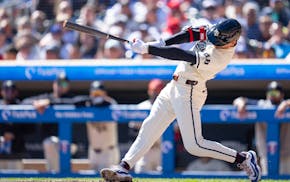After pausing to ponder the question, Wild winger Zach Parise was dumbfounded, as was coach Bruce Boudreau.
"I can't tell you why," Parise said.
"I don't have an answer," Boudreau said.
The pair were stumped when asked why they thought teams in the NHL this season were converting power plays at their highest rate since 1989-90.
"I probably would've thought the opposite with all the shot blocking that goes on and video [game planning] and stuff," Parise said.
One reason for the league's overall increase in scoring this season has been the proficiency of power plays. Entering Sunday, teams were converting at a 19.9 percent rate, which is up from 19.1 a season ago and represents a 2 percent jump from the 2013-14 season.
The league is flirting with the 20 percent mark for the first time since 1989-90 (20.8). That was the last of 13 consecutive seasons in which the success rate was above 20 percent. Then it gradually began to dip, with the nadir coming at 15.1 percent in 1997-98, the lowest power-play percentage ever, according to Hockey Reference, which tracks power-play percentage as far back as 1963. The Wild is ninth this season in power-play percentage (21.4 percent) and 16th in kill percentage (80.6).
Some might cite the league instituting an automatic offensive zone faceoff at the start of a power play as a reason for the increase, but that rule change came in 2008.
The league had an immediate uptick in power-play production (17.8 percent in 2007-08 increased to 19 percent in 2008-09), but that was a temporary bump — it decreased to 17.3 percent in 2011-12, before trending upward to now.
It's not just the Wild puzzled by the increase. Coyotes defenseman Niklas Hjalmarsson said, "I don't really have an answer to that."
Blackhawks forward Tommy Wingels said he wasn't sure why either before saying that as a penalty killer he had to be cognizant of more players who had the ability to score from anywhere on the ice.
"How hard guys shoot is at an all-time high. I think those factors contribute to a more lethal power play. It's extremely hard to defend," Wingels said. "There are more and more guys whose shots you have to be aware of. Before you're maybe aware of one guy who's got a really hard shot. You have that in the back of your mind now. Power plays have two, three guys who can really hammer the puck."
Wild defenseman Nate Prosser said he thought teams had to face more power plays per game, and that contributed to more power-play goals.
His reasoning is that it's easier to go 0-for-3 for two consecutive games and get a total of six kills than it is to get five or six kills in the same game because of the energy players must spend on the kill.
"When you get up in six, seven minors per game, you have a lot of key guys who are killing penalties," Prosser said. "You wear down and they can get an easy one on you."
But the thing is — the numbers don't quite back that up. Power-play opportunities are at 3.16 per game, up from 2.99 a season ago but still trail significantly behind where the league was 10-20 years ago, when power-play opportunities ranged from 4.03 per game in 1999-2000 to a whopping 5.85 in 2005-06.
This increase in power-play percentage is taking place as teams are studying more film and know the tendencies of other teams' strategies.
"Coaches and our video guys are so dang good nowadays that we'll do our PK reps tomorrow morning and watch their video, everything they've done over the last five or six games we're going to see on video," Prosser said.
"Is this guy walking to the middle and shooting? Is he more of a disher? More of a one-timer? We get a read on all that stuff."
Even so, penalty killers are fighting an increasingly uphill battle. Perhaps the pendulum will swing back at some point, but for now, the power plays have all the power.
Chris Hine is the lead writer for North Score, the Star Tribune's new sports analytics beat. Find his stories at startribune.com/northscore.

Live: Minnesota United at Charlotte FC. Follow on Gameview.
Jameson Taillon comes off the injured list and helps the Cubs beat the Marlins 8-3
T-wolves take NBA's best defense into series vs. Suns, but can it stop Durant-Booker-Beal trio?
